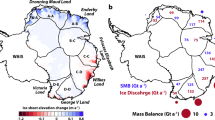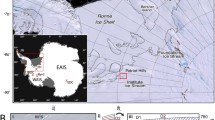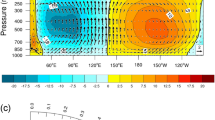Abstract
The “Panama Hypothesis” states that the gradual closure of the Panama Seaway, between 13 million years ago (13 Ma) and 2.6 Ma, led to decreased mixing of Atlantic and Pacific water Masses, the formation of North Atlantic Deep water and strengthening of the Atlantic thermohaline circulation, increased temperatures and evaporation in the North Atlantic, increased precipitation in Northern Hemisphere (NH) high latitudes, culminating in the intensification of Northern Hemisphere Glaciation (NHG) during the Pliocene, 3.2–2.7 Ma. Here we test this hypothesis using a fully coupled, fully dynamic ocean-atmosphere general circulation model (GCM) with boundary conditions specific to the Pliocene, and a high resolution dynamic ice sheet model. We carry out two GCM simulations with “closed” and “open” Panama Seaways, and use the simulated climatologies to force the ice sheet model. We find that the models support the “Panama Hypothesis” in as much as the closure of the seaway results in a more intense Atlantic thermohaline circulation, enhanced precipitation over Greenland and North America, and ultimately larger ice sheets. However, the volume difference between the ice sheets in the “closed” and “open” configurations is small, equivalent to about 5 cm of sea level. We conclude that although the closure of the Panama Seaway may have slightly enhanced or advanced the onset of NHG, it was not a major forcing mechanism. Future work must fully couple the ice sheet model and GCM, and investigate the role of orbital and CO2 effects in controlling NHG.














Similar content being viewed by others
References
Bamber JL, Layberry RL, Gogenini SP (2001a) A new ice thickness and bed data set for the Greenland ice sheet 1: Measurement, data reduction, and errors. J Geophys Res 106(D24):33773–33780
Bamber JL, Layberry RL, Gogenini SP (2001b) A new ice thickness and bed data set for the Greenland ice sheet 2: Relationship between dynamics and basal topography. J Geophys Res 106(D24):33781–33788
Barreiro M, Philander G, Pacanowski R, Fedorov A (2005) Simulations of warm tropical conditions with application to middle Pliocene atmospheres. Clim Dyn 26(4):349–365. doi:10.1007/s00382-005-0086-4
Bartoli G, Sarnthein M, Weinelt M, Erlenkeuser H, Garbe-Schonberg D, Lea W (2005) Final closure of Panama and the onset of Northern Hemisphere glaciation. Earth Planet Sci Lett 237:33–44
Bauer E, Ganopolski A, Montoya M (2004) Simulation of the cold climate event 8200 years ago by meltwater outburst from Lake Agassiz. Paleoceanography 19:PA3014
Berger A, Li XS, Loutre MF (1999) Modelling northern hemisphere ice volume over the last 3 Ma. Quat Sci Rev 18:1–11
Berggren WA, Kent DV, Swisher CC, Aubry MP (1995) A revised Cenozoic geochronology and chronostratigraphy. In: Berggren WA, Kent DV, Aubry MP, Hardenbol J (eds) Geochronology, time scales and global stratigraphic correlation, vol 54. Tulsa, Society for sedimentary geology special publication, pp 129–212
Bryan K (1969) Climate and the ocean circulation. III. The ocean model. Mon Wea Rev 97:806–827
Cattle H, Crossley J (1995) Modelling Arctic climate change. Philos Trans R Soc Lond A 352:201–213
Cox P, Betts R, Bunton C, Essery R, Rowntree PR, Smith J (1999) The impact of new land-surface physics on the GCM simulation and climate sensitivity. Clim Dyn 15:183–203
Cusack S, Slingo A, Edwards JM, Wild M (1998) The radiative impact of a simple aerosol climatology on the Hadley Centre GCM. Q J R Meteorol Soc 124:2517–2526
DeConto RM, Pollard D (2003) Rapid Cenozoic glaciation of Antarctica induced by declining atmospheric CO2. Nature 421:245–249
Dowsett HJ, Cronin TM (1990) High eustatic sea level during the Middle Pliocene: evidence from the southeastern U.S. Atlantic Coastal Plain. Geology 18:435–438
Dowsett HJ, Barron JA, Poore RZ, Thompson RS, Cronin TM, Ishman SE, Willard DA (1999) Middle Pliocene paleoenvironmental reconstruction: PRISM2. USGS Open File Report 99-535. http://pubs.usgs.gov/of/1999/of99-535/
Edwards JM, Slingo A (1996) Studies with a flexible new radiation code 1: choosing a configuration for a large-scale model. Q J R Meteorol Soc 122:689–719
Fedorov AV, Dekens PS, McCarthy M, Ravelo AC, de Menocal PB, Barreiro M, Pacanowski RC, Philander SG (2006) The Pliocene paradox (mechanisms for a permanent El Niño). Science 312:1485–1489
Fulton RJ (1995) Surficial materials of Canada, Geological Survey of Canada, Map 1880A, scale 1:15,000,000
Gent PR, McWilliams JC (1990) Isopycnal mixing in ocean circulation models. J Phys Oceanogr 20:150–155
Gordon C, Cooper C, Senior CA, Banks H, Gregory JM, Johns TC, Mitchell JFB, Wood RA (2000) The simulation of SST, sea ice extents and ocean heat transports in a version of the Hadley Centre coupled model without flux adjustments. Clim Dyn 16:147–168
Gregory JM, Mitchell JFB (1997) The climate response to CO2 of the Hadley Centre coupled AOGCM with and without flux adjustment. Geophys Res Lett 24:1943–1946
Gregory D, Kershaw R, Inness PM (1997) Parametrisation of momentum transport by convection II: tests in single column and general circulation models. Q J R Meteorol Soc 123:1153–1183
Hanna E, McConnell J, Das S, Cappelen J, Stephens A (2006) Observed and modeled Greenland ice sheet snow accumulation, 1958–2003, and links with regional climate forcing. J Clim 19:344–358
Haug GH, Tiedemann R (1998) Effect of the formation of the Isthmus of Panama on Atlantic Ocean thermohaline circulation. Nature 393:673–676
Haug GH, Tiedemann R, Zahn R, Ravelo AC (2001) Role of Panama uplift on oceanic freshwater balance. Geology 29:207–210
Haywood AM, Valdes PJ (2004) Modelling Middle Pliocene warmth: contribution of atmosphere, oceans and cryosphere. Earth Planet Sci Lett 218:363–377
Haywood AM, Valdes PJ, Sellwood BW (2000) Global scale palaeoclimate reconstruction of the middle Pliocene climate using the UKMO GCM: initial results. Glob Planet Change 25(1–3):239–256
Haywood AM, Dekens P, Ravelo AC, Williams M (2005) Warmer tropics during the mid Pliocene? Evidence from alkenone paleothermometry and a fully coupled ocean-atmosphere GCM. Geochem Geophys Geosyst 6(3) doi:10.1029/2004GC000799
Hibler WD (1979) A dynamic thermodynamic sea ice model. J Phys Oceanogr 9:815–846
Hodell DA, Kennett JP (1985) Miocene paleoceanography of the South Atlantic Ocean at 22, 16, and 8 Ma. In: Kennett JP (ed) The Miocene Ocean: paleoceanography and biogeography, vol 163. Geological Society of America (GSA), Boulder, pp 317–337
Hulbert RC, Harington CR (1999) An early Pliocene hipparionine horse from the Canadian Arctic. Paleontology 42:1017–1025
Huybrechts P (1996) Basal temperature conditions of the Greenland ice sheet during the glacial cycles. Ann Glaciol 23:226–236
IPCC (2001) Climate change 2001: the scientific basis. In: Houghton JT, Ding Y, Griggs DJ, Noguer M, van der Linden PJ, Xiaosu D (eds). Cambridge University Press, UK, pp 944
Keigwin LD (1982) Isotopic paleoceanography of the Caribbean and east Pacific: role of Panama uplift in late Neogene time. Science 217:350–352
Klocker A, Prange M, Schulz M (2005) Testing the influence of the Central American seaway on orbitally forced Northern Hemisphere glaciation. Geophys Res Lett 32:L03703. doi:10.1029/2004GL021564
Kürschner WM, Van der Burgh J, Visscher H, Dilcher DL (1996) Oak leaves as biosensors of late Neogene and early Pleistocene paleoatmospheric CO2 concentrations. Mar Micropaleontol 27:299–312
Lambeck K, Nakiboglu SM (1980) Seamount loading and stress in the ocean lithosphere. J Geophys Res 85:6403–6418
Lear CH, Rosenthal Y, Wright JD (2003) The closing of a seaway: ocean water masses and global climate change. Earth Planet Sci Lett 210:425–436
Lunt DJ, de Noblet-Ducoudre N, Charbit S (2004) Effects of a melted Greenland ice sheet on climate, vegetation, and the crysophere. Clim Dyn 23(7–8):679–694
Maier-Reimer E, Mikolajewicz U, Crowley T (1990) Ocean general circulation model sensitivity experiment with an open Central American Isthmus. Paleoceanography 5:349–366
Manabe S, Stouffer RJ (1988) Two stable equilibria of a coupled ocean-atmosphere model. J Clim 1:841–866
Marshall LG, Webb SD, Sepkoski JJ, Raup DM (1982) Mammalian evolution and the great american interchange. Science 215:1351–1357
Maslin MA, Li XS, Loutre MF, Berger A (1998) The contribution of orbital forcing to the progressive intensification of Northern Hemisphere glaciation. Quat Sci Rev 17:411–426
Mikolajewicz U, Crowley TJ (1997) Response of a coupled ocean/energy balance model to restricted flow through the Central American Isthmus. Paleoceanography 12:429–441
Mikolajewicz U, Maier-Reimer E, Crowley T, Kim KY (1993) Effect of Drake and Panamanian Gateways on the circulation of an ocean model. Paleoceanography 8:409–426
Murdock TQ, Weaver AJ, Fanning AF (1997) Paleoclimatic response of the closing of the Isthmus of Panama in a coupled ocean-atmosphere model. Geophys Res Lett 24:253–256
Nisancioglu KH, Raymo ME, Stone PH (2003) Reorganization of Miocene deep water circulation in response to the shoaling of the Central American Seaway. Paleoceanography 18:1006. doi:10.1029/2002PA000767
Otto-Bliesner BL, Brady EC, Shields C (2002) Late Cretaceous ocean: coupled simulations with the National Center for Atmospheric Research Climate System Model. J Geophys Res 107(D2):4019. doi:10.1029/2001JD000821
Payne AJ (1999) A thermomechanical model of ice flow in West Antarctica. Clim Dyn 15:115-125
Philander GS, Fedorov AV (2003) Role of tropics in changing the response to Milankovich forcing some three million years ago. Paleoceanography 18. doi:10.1029/2002PA000837
Peixoto JP, Oort AH (1992) Physics of climate. Springer, New York, pp 345
Pollard D, Thompson SL (1997) Driving a high-resolution dynamic ice sheet model with GCM climate: ice-sheet initiation at 116,000 BP. Ann Glaciol 25:296–304
Prange M, Schulz M (2004) A coastal upwelling seesaw in the Atlantic Ocean as a result of the closure of the Central American Seaway. Geophys Res Lett 31:L17207. doi:10.1029/2004GL020073
Prange M, Schulz M (2006) Panamanian gateway closure chilled North America: a dynamical impact of the atmosphere on Northern Hemisphere glaciation. Geophysical Research Abstracts, 8, EGU—3rd General Assembly, Vienna
Ravelo AC, Andreasen DH, Lyle M, Lyle AO, Wara MW (2004) Regional climate shifts caused by gradual global cooling in the Pliocene epoch. Nature 42:263–267
Ravelo AC, Dekens PS, McCarthy M (2006) Evidence for El Nino-like conditions during the Pliocene. GSA Today 16:4–11
Raymo ME (1994) The initiation of Northern Hemisphere glaciation. Annu Rev Earth Planet Sci 22:353–383
Raymo ME, Grant B, Horowitz M, Rau GH (1996) Mid-Pliocene warmth: stronger greenhouse and stronger conveyor. Mar Micropaleontol 27:313–326
Rea DK, Snoeckx H, Joseph LH (1998) Late Cenozoic Eolian deposition in the North Pacific: Asian drying, Tibetan uplift, and cooling of the Northern Hemisphere. Paleoceanography 13:215–224
Reeh (1991) Parameterization of melt rate and surface temperature on the Greenland ice sheet. Polarforschung 59/3:113–128
Schmidt DN (2007) The closure history of the Panama Isthmus: evidence from isotopes and fossils to models and molecules. In: Williams M, Haywood AM, Gregory JF, Schmidt DN (eds) Deep time perspectives on climate change—marrying the signal from computer models and biological proxies. Geological Society of London, London (in press)
Schneider B, Schmittner A (2006) Simulating the impact of the Panamanian seaway closure on ocean circulation, marine productivity and nutrient cycling. Earth Planet Sci Lett 246:367–380
Shackleton NJ, Le J, Mix A, Hall MA (1992) Carbon isotope records from Pacific surface waters and atmospheric carbon dioxide. Quat Sci Rev 11:387–400
Steph S, Tiedemann R, Prange M, Groenveld J, Nurnberg D, Reuning L, Schulz M, Haug GH (2006) Changes in Caribbean surface hydrography during the Pliocene shoaling of the Central American Seaway. Paleoceanography 21:PA4221. doi:10.1029/2004PA001092
Tedford RH, Harington CR (2003) An Arctic mammal fauna from the Early Pliocene of North America. Nature 425:388–390
US Department of Commerce, National Oceanic and Atmospheric Administration, National Geophysical Data Center (2001) 2-minute Gridded Global Relief Data (ETOPO2). http://www.ngdc.noaa.gov/mgg/fliers/01mgg04.html
Van der Burgh J, Visscher H, Dilcher DL, Kürschner WM (1993) Paleoatmospheric signatures in Neogene fossils leaves. Science 260:1788–1790
Von der Heydt A, Dijkstra HA (2005) Flow reorganizations in the Panama Seaway: a cause for the demise of Miocene corals? Geophys Res Lett 32:2, Art. No. L02609. doi:10.1029/2004GL020990
Acknowledgements
This work was carried out in the framework of the British Antarctic Survey GEACEP (Greenhouse to ice-house: Evolution of the Antarctic Cryosphere And Palaeoenvironment) programme. We thank three anonymous reviewers for their useful comments. Thanks to Daniela Schmidt for useful discussions concerning the paleodata.
Author information
Authors and Affiliations
Corresponding author
Rights and permissions
About this article
Cite this article
Lunt, D.J., Valdes, P.J., Haywood, A. et al. Closure of the Panama Seaway during the Pliocene: implications for climate and Northern Hemisphere glaciation. Clim Dyn 30, 1–18 (2008). https://doi.org/10.1007/s00382-007-0265-6
Received:
Accepted:
Published:
Issue Date:
DOI: https://doi.org/10.1007/s00382-007-0265-6




